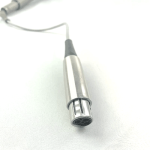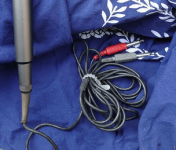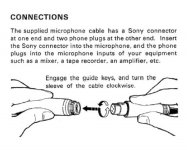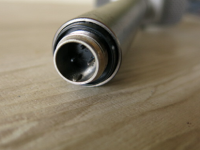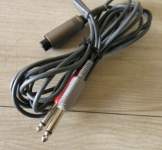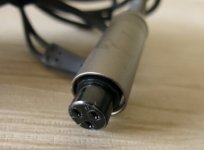I'm just browsing for potential buys online - can anyone identify this connector? It sort of looks like XLR, but I don't know, the image isn't very good quality. Also, there's another cable with dual 1/4 stereo connectors (left/right channels). I believe this cable was used to for tape decks of the time. Are there any simple adapters I could buy/easy methods to convert either of these cable types to use with a more conventional XLR connection or even 3.5mm or would dealing with this be too much hassle?
-
 ✅ Technical and creative solutions for your film.
✅ Technical and creative solutions for your film.
✅ Screenplay formatting help, plot and story guidance.
✅ A respectful community of professionals and newbies.
✅ Network with composers, editors, cast, crew, and more!
🎬 IndieTalk - Filmmaking and Screenwriting help site and community.
By filmmakers, for filmmakers since 2003
You are using an out of date browser. It may not display this or other websites correctly.
You should upgrade or use an alternative browser.
You should upgrade or use an alternative browser.
sound-gear (Adapting) vintage stereo microphone with unknown connector type (?)
- Thread starter Ven
- Start date
Solution
Sorry about that, I forgot to mention that the microphone is Sony ECM-990F.
That's the missing piece! Okay, I still cannot find any information on the "Sony connector", but I did look up the operation manual and look over the specs, which gave me some helpful information. Here's a direct link to the Operation Manaul: LINK
This is a stereo mic that was made to go with a Sony portable cassette recorder. Even without a part number on the connector, here's what you need to know:
This is a 3-pin connector on a stereo mic, and the cable terminates the other end with dual 1/4" TS (tip-sleeve) connectors. These are unbalanced connections. A digital multimeter will tell you how the pinout is wired, but essentially you have a pin...
Here you go:
As an Amazon Associate we earn from qualifying purchases.
Thank you but i'm thinking that will not work. I've found a bit more info and it seems the mic uses a special connector type. I wonder about an adapter to convert the two 1/4 stereo plugs to one 3.5mm plug? I haven't been able to find one online yet.
Attachments
Last edited:
As an Amazon Associate we earn from qualifying purchases.
@AcousticAl our resident sound guy will know!
Will he, though?@AcousticAl our resident sound guy will know!
Need more information, like... which microphone are you looking at that includes this cable, @Ven ? That information will help immensely.
Not knowing make/model of the microphone... it looks almost like GX16 docking-style aviation connector, but maybe not. The fact that the diagram posted above just calls it a "Sony connector" also isn't helpful. There's nothing coming up under that name for an audio connector.
But then... who knows what a "Cannon" connector is these days? We just call it XLR. And do any of you know what an Amphenol connector is? You don't find those too often these days, either.
Last edited:
Always great when you show up!
I've never seen that adapter.
I've never seen that adapter.
Sorry about that, I forgot to mention that the microphone is Sony ECM-990F. Ex: https://www.ebay.com/itm/395383967194
There's a 990 and a 990F model. The 990 has 600 impedance, no battery light and the 990F has 200 impedance and has a battery indicator. I suppose the F is the later model, then (?) I actually have what appears to be a nice, working condition F model on the way now. I forgot until now that I bought a Beachtek DXA Pro+ about 3 months ago.. that has 1/8" plugs for both L/R channels plus a mono/stereo switch should I need to use it if it agrees with the microphone.
But for a simpler setup, or for recording events - so should the splitter be mono for the 2 1/4" plugs and stereo on the 1/8 end? Will it matter if the 1/4" plugs are stereo? I may have one of those adapters around but i'll buy the other one if I need to. And for XLR for on-camera use - my JVC has 2 XLR inputs.. so 1/4" > 1/8" > to 1/8" to XLR adapters for each channel?
The 990 manual is an interesting read online. Here's a thread I found with some useful information: https://www.vintage-radio.net/forum/showthread.php?t=24406
"Quite a few references to it and one which mentions it has a special connector."
Sounds like the cable is proprietary, and maybe the connector, too. So i'm glad I didn't buy the one without it. Thanks for everyone's help!
There's a 990 and a 990F model. The 990 has 600 impedance, no battery light and the 990F has 200 impedance and has a battery indicator. I suppose the F is the later model, then (?) I actually have what appears to be a nice, working condition F model on the way now. I forgot until now that I bought a Beachtek DXA Pro+ about 3 months ago.. that has 1/8" plugs for both L/R channels plus a mono/stereo switch should I need to use it if it agrees with the microphone.
But for a simpler setup, or for recording events - so should the splitter be mono for the 2 1/4" plugs and stereo on the 1/8 end? Will it matter if the 1/4" plugs are stereo? I may have one of those adapters around but i'll buy the other one if I need to. And for XLR for on-camera use - my JVC has 2 XLR inputs.. so 1/4" > 1/8" > to 1/8" to XLR adapters for each channel?
The 990 manual is an interesting read online. Here's a thread I found with some useful information: https://www.vintage-radio.net/forum/showthread.php?t=24406
"Quite a few references to it and one which mentions it has a special connector."
Sounds like the cable is proprietary, and maybe the connector, too. So i'm glad I didn't buy the one without it. Thanks for everyone's help!
Sorry about that, I forgot to mention that the microphone is Sony ECM-990F.
That's the missing piece! Okay, I still cannot find any information on the "Sony connector", but I did look up the operation manual and look over the specs, which gave me some helpful information. Here's a direct link to the Operation Manaul: LINK
This is a stereo mic that was made to go with a Sony portable cassette recorder. Even without a part number on the connector, here's what you need to know:
This is a 3-pin connector on a stereo mic, and the cable terminates the other end with dual 1/4" TS (tip-sleeve) connectors. These are unbalanced connections. A digital multimeter will tell you how the pinout is wired, but essentially you have a pin connected to the tip L, a pin connected to the tip R, and a common ground pin connected to the sleeves on both L and R. And that brings us to what you're trying to accomplish:
I forgot until now that I bought a Beachtek DXA Pro+ about 3 months ago.. that has 1/8" plugs for both L/R channels plus a mono/stereo switch should I need to use it if it agrees with the microphone.
But for a simpler setup, or for recording events - so should the splitter be mono for the 2 1/4" plugs and stereo on the 1/8 end? Will it matter if the 1/4" plugs are stereo? I may have one of those adapters around but i'll buy the other one if I need to.
Each 1/4" TS connector is a mono signal from the mic, either the L or the R. What's on the other end of your adapter depends on what kind of device (and connector) you're trying to feed. A device with a mic input on 3.5mm TRS is likely taking a stereo signal (Tip Ring Sleeve: tip = L, ring = R, sleeve = GND). Read the device specs to know for sure, but assuming that's the case, then a dual 1/4" TS > 3.5mm TRS cable will fit the bill.
And to clarify mono vs. stereo, and TS vs. TRS: these aren't always the same thing. "Stereo" indicates two channels of audio that work together to create an image with width and depth. "Mono" indicates a single channel of audio.
TRS indicates three conductors (separate runs of copper) in the cable, whereas TS indicates two conductors. Is TRS stereo? Well, maybe. If it's carrying a left, right, and ground, then... yes. But it can also carry a balanced (separate positive, negative, and ground) mono signal. The XLR inputs on your camera are balanced mono inputs. (And an unbalanced signal has only two separate conductors carrying the mono signal: positive, and combination negative/ground.)
Your Beachtek has 3.5mm L and R inputs, but also has a 3.5mm stereo input. Use the stereo input with the right adapter cable (dual 1/4" TS > 3.5mm TRS).
And for XLR for on-camera use - my JVC has 2 XLR inputs.. so 1/4" > 1/8" > to 1/8" to XLR adapters for each channel?
That's a lot of adapters in one chain. You need to simplify. There are inline 1/4" TS > XLR adapters that will perform the impedance conversion so you can connect your unbalanced, 1/4" TS cables to the balanced, XLR inputs of your camera.
Sounds like the cable is proprietary, and maybe the connector, too. So i'm glad I didn't buy the one without it. Thanks for everyone's help!
I'm going to make a couple more calls and see if I can get an ID on that Sony connector. If it's a part that's still available, it's entirely possible to custom-wire cables so that you have one for each use case, whether it's 3.5mm stereo in on your Beachtek, or your camera's XLR inputs.
Last edited:
Hey, I was tired when I made the original post, cripes!

I found a couple pictures with what appears to be a dual XLR cable, so I guess that it was possible, at least at one point. I wonder if in doing so, that the original cable connector was "sacrificed" for the conversion.


Thank you AcousticAl for the excellent information! I found a topic about the 990F on Reddit that includes a good picture of the connector:

Al, I think I found a correct splitter on ebay - does this one look right to you? Hosa YMP-137 Stereo Breakout, 3.5 mm TRS Male to Dual 1/4 in TS Female
I found a couple pictures with what appears to be a dual XLR cable, so I guess that it was possible, at least at one point. I wonder if in doing so, that the original cable connector was "sacrificed" for the conversion.
Thank you AcousticAl for the excellent information! I found a topic about the 990F on Reddit that includes a good picture of the connector:
Al, I think I found a correct splitter on ebay - does this one look right to you? Hosa YMP-137 Stereo Breakout, 3.5 mm TRS Male to Dual 1/4 in TS Female
I found a couple pictures with what appears to be a dual XLR cable, so I guess that it was possible, at least at one point. I wonder if in doing so, that the original cable connector was "sacrificed" for the conversion.
It's entirely possible that Sony made that cable as an optional accessory. It's also entirely possible that someone custom-modded that from the stock (dual 1/4") cable. Who knows?
Yeah, this is the deepening mystery. It's definitely not XLR, and the pins are flat instead of round. I'm beginning tho think it was some kind of strange, proprietary connector that Sony made only for these mics, and not something that was in wider use. That makes it much more difficult to find a part number, or any new or NOS parts.
I just talked to a longtime electronics repair (everything from home stereo equipment to professional recording gear) guy who had never seen it before. My next call is going to be to a decades-long broadcast engineer with whom I worked at my first job in TV (undisclosed number of years ago...
Al, I think I found a correct splitter on ebay - does this one look right to you? Hosa YMP-137 Stereo Breakout, 3.5 mm TRS Male to Dual 1/4 in TS Female
That should to it. In this use case, however, it's functioning as a combiner, not a splitter.
Last edited:
Al, another question if you don't mind.. should the "R" XLR plug on the Beachtek work with one of these cables 3-Pin XLR Male to Male mic Cable DMX Cable Patch Cords with Oxygen-Free Copper out to the XLR input on the camera? Just trying to picture all of this in my head. (So microphone 1/4 with 1/8 dual adapter into Beachtek stereo port, "R" XLR port with male/male patch cable out to camera XLR port)
Last edited:
Al, another question if you don't mind.. should the "R" XLR plug on the Beachtek work with one of these cables 3-Pin XLR Male to Male mic Cable DMX Cable Patch Cords with Oxygen-Free Copper out to the XLR input on the camera? Just trying to picture all of this in my head. (So microphone 1/4 with 1/8 dual adapter into Beachtek stereo port, "R" XLR port with male/male patch cable out to camera XLR port)
So, you want to connect an input to an input? No, that’s not going to work.
Oh. Yeah. Oops, haha. Maybe i'll do better now that i've rested.

Hosa YMP-137 Dual Stereo adapter from mic into Beachktek Stereo input, 1/4 to 1/8 stereo cable (1/8 end into Beachtek Out), 1/4 end into Hosa MIT-129 Impedance Transformer, Hosa transformer XLR end into camera XLR port. (?)
Thank you for everything, sincerely. I couldn't do this without your help. I love learning and it's always the first steps that are the most difficult. Thankfully, one only has to learn how to ride a bike once.. hopefully.



Hosa YMP-137 Dual Stereo adapter from mic into Beachktek Stereo input, 1/4 to 1/8 stereo cable (1/8 end into Beachtek Out), 1/4 end into Hosa MIT-129 Impedance Transformer, Hosa transformer XLR end into camera XLR port. (?)
Thank you for everything, sincerely. I couldn't do this without your help. I love learning and it's always the first steps that are the most difficult. Thankfully, one only has to learn how to ride a bike once.. hopefully.
Last edited:
Hosa YMP-137 Dual Stereo adapter from mic into Beachktek Stereo input, 1/4 to 1/8 stereo cable (1/8 end into Beachtek Out), 1/4 end into Hosa MIT-129 Impedance Transformer, Hosa transformer XLR end into camera XLR port. (?)
Here’s where we get back to the topic of mono/stereo vs. unbalanced/balanced.
In this scenario, you’re taking a stereo (2-channel) unbalanced output and trying to connect it to a mono balanced input. Here’s the problem: that cable terminates in a 1/4” TRS that carries L, R, GND. The impedance transformer is expecting a 1/4” TS (Positive, Neg/GND) signal, so you’re going to be connecting L to the Positive, and both the R and GND will make contact together on the Neg/GND pin. Results may vary.
But I think you’re overcomplicating things. Why use the Beachtek at all in this scenario? Your camera has XLR inputs. Why not just connect L and R 1/4” TS with the mic’s stock cable, putting one of the Hosa trasformer/adapters on each one? Cut out the middle man.
Which camera are you using, by the way?
Oh, I think I understand, thank you. Yeah, I suppose I can still try it, I mean since I need to buy 2 of them anyway for using directly into the camera. What about using one of those cheap non-transformer 1/4 to XLR adapters? Is that more likely to cause less problems with that setup or worse?
I don't have to use that setup, but it would be much easier to control the audio levels on-the-fly with the bigger dials, and figured the pre-amp would help with any low volume the mic may have. (that thought comes from people online claiming these back electret mics can "lose their charge" over time, affecting volume levels - not sur how true it is - suppose I was just being a bit precautionary about it)
I would be mainly using a JVC GY-HM150. (Specs. info)
COMPACT HAND-HELD 3-CCD CAMCORDER

I don't have to use that setup, but it would be much easier to control the audio levels on-the-fly with the bigger dials, and figured the pre-amp would help with any low volume the mic may have. (that thought comes from people online claiming these back electret mics can "lose their charge" over time, affecting volume levels - not sur how true it is - suppose I was just being a bit precautionary about it)
I would be mainly using a JVC GY-HM150. (Specs. info)
COMPACT HAND-HELD 3-CCD CAMCORDER


